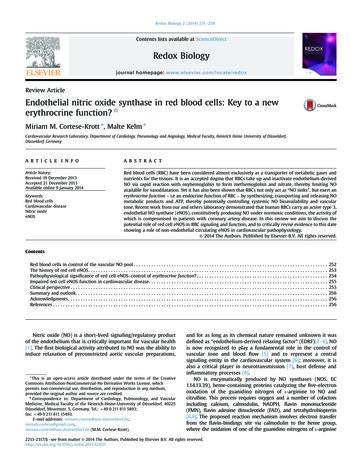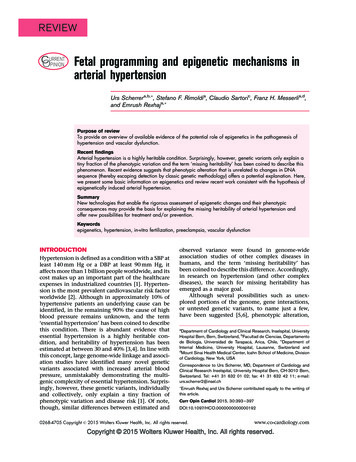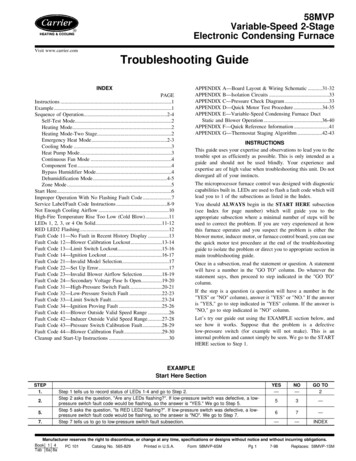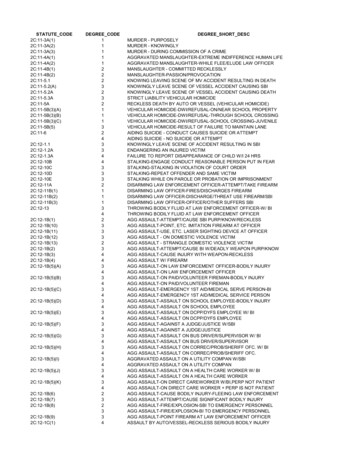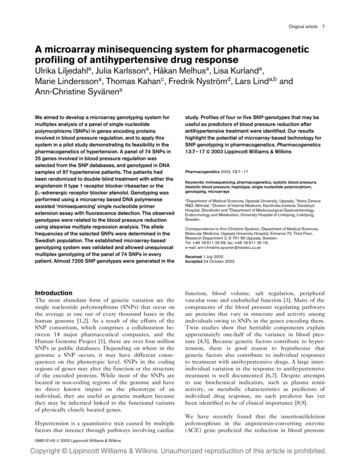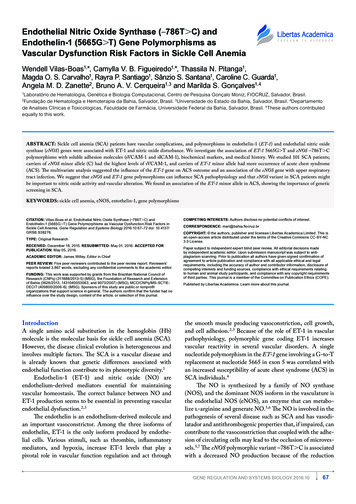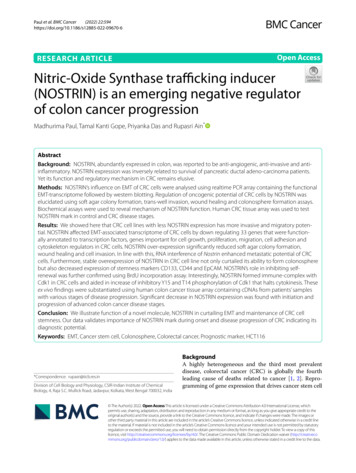
Transcription
(2022) 22:594Paul et al. BMC en AccessRESEARCH ARTICLENitric‑Oxide Synthase trafficking inducer(NOSTRIN) is an emerging negative regulatorof colon cancer progressionMadhurima Paul, Tamal Kanti Gope, Priyanka Das and Rupasri Ain*AbstractBackground: NOSTRIN, abundantly expressed in colon, was reported to be anti-angiogenic, anti-invasive and antiinflammatory. NOSTRIN expression was inversely related to survival of pancreatic ductal adeno-carcinoma patients.Yet its function and regulatory mechanism in CRC remains elusive.Methods: NOSTRIN’s influence on EMT of CRC cells were analysed using realtime PCR array containing the functionalEMT-transcriptome followed by western blotting. Regulation of oncogenic potential of CRC cells by NOSTRIN waselucidated using soft agar colony formation, trans-well invasion, wound healing and colonosphere formation assays.Biochemical assays were used to reveal mechanism of NOSTRIN function. Human CRC tissue array was used to testNOSTRIN mark in control and CRC disease stages.Results: We showed here that CRC cell lines with less NOSTRIN expression has more invasive and migratory potential. NOSTRIN affected EMT-associated transcriptome of CRC cells by down regulating 33 genes that were functionally annotated to transcription factors, genes important for cell growth, proliferation, migration, cell adhesion andcytoskeleton regulators in CRC cells. NOSTRIN over-expression significantly reduced soft agar colony formation,wound healing and cell invasion. In line with this, RNA interference of Nostrin enhanced metastatic potential of CRCcells. Furthermore, stable overexpression of NOSTRIN in CRC cell line not only curtailed its ability to form colonospherebut also decreased expression of stemness markers CD133, CD44 and EpCAM. NOSTRIN’s role in inhibiting selfrenewal was further confirmed using BrdU incorporation assay. Interestingly, NOSTRIN formed immune-complex withCdk1 in CRC cells and aided in increase of inhibitory Y15 and T14 phosphorylation of Cdk1 that halts cytokinesis. Theseex vivo findings were substantiated using human colon cancer tissue array containing cDNAs from patients’ sampleswith various stages of disease progression. Significant decrease in NOSTRIN expression was found with initiation andprogression of advanced colon cancer disease stages.Conclusion: We illustrate function of a novel molecule, NOSTRIN in curtailing EMT and maintenance of CRC cellstemness. Our data validates importance of NOSTRIN mark during onset and disease progression of CRC indicating itsdiagnostic potential.Keywords: EMT, Cancer stem cell, Colonosphere, Colorectal cancer, Prognostic marker, HCT116*Correspondence: rupasri@iicb.res.inDivision of Cell Biology and Physiology, CSIR-Indian Institute of ChemicalBiology, 4, Raja S.C. Mullick Road, Jadavpur, Kolkata, West Bengal 700032, IndiaBackgroundA highly heterogeneous and the third most prevalentdisease, colorectal cancer (CRC) is globally the fourthleading cause of deaths related to cancer [1, 2]. Reprogramming of gene expression that drives cancer stem cell The Author(s) 2022. Open Access This article is licensed under a Creative Commons Attribution 4.0 International License, whichpermits use, sharing, adaptation, distribution and reproduction in any medium or format, as long as you give appropriate credit to theoriginal author(s) and the source, provide a link to the Creative Commons licence, and indicate if changes were made. The images orother third party material in this article are included in the article’s Creative Commons licence, unless indicated otherwise in a credit lineto the material. If material is not included in the article’s Creative Commons licence and your intended use is not permitted by statutoryregulation or exceeds the permitted use, you will need to obtain permission directly from the copyright holder. To view a copy of thislicence, visit http:// creat iveco mmons. org/ licen ses/ by/4. 0/. The Creative Commons Public Domain Dedication waiver (http:// creat iveco mmons. org/ publi cdoma in/ zero/1. 0/) applies to the data made available in this article, unless otherwise stated in a credit line to the data.
Paul et al. BMC Cancer(2022) 22:594self-renewal and turns on metastatic progression enablesCRC disease progression. Several molecular pathwaysand genetic aberrations have already been identified thatcontribute to development and metastatic progression ofthis disease, yet overall survival rate of colorectal cancerpatients seem to be low [3, 4]. Thus, further identificationof new targets to restrict colon cancer progression as wellas understanding the underlying regulatory mechanismsthat drive metastatic progression and CRC stem cellself-renewal is a crucial step towards improving patientoutcomes.NOSTRIN (Nitric Oxide Synthase Trafficking INducer)is abundantly expressed in colon. It is classically knownas an endothelial cell protein that sequesters eNOS andinhibits NO production [5]. However, various eNOSdependent and independent functions of NOSTRIN havebeen demonstrated till date [6–9]. Owing to its functionas an adapter protein, NOSTRIN interacts with otherproteins depending on cellular context and exhibits pleiotropic functions [10–12]. Interestingly, NOSTRIN hasbeen shown to possess potent anti-angiogenic, anti-invasive and anti-inflammatory functions in endothelial cells[9]. Besides, NOSTRIN was shown to be involved in inhibition of cell cycle progression [12]. Angiogenesis andinvasion form an integral mechanism of cancer growthand metastasis [13], and aberrant cell cycle progressionis a hallmark of cancer progression. We, therefore, arguedthat NOSTRIN might possess anti-cancer properties inCRC cells.Interestingly, NOSTRIN was identified as one of the36 gene signatures representing prognostic predictor ofclinical outcome in pancreatic ductal adenocarcinoma(PDAC), wherein NOSTRIN down-regulation was associated with poor outcome [14]. Similar results in PDACpatients were also reported by Wang et al. [15]. In addition, overexpression of NOSTRIN curtailed cell invasionand gemcitabine-induced apoptotic cell death in humanpancreatic cancer cell line [15]. NOSTRIN’s ability tosequester eNOS and consequently its dampening effecton NO production by endothelial cells has been implicated in cancer progression [16]. Interestingly, combined use of NOS inhibitors with 5-fluorouracil showedenhanced inhibition of cell proliferation and migrationin CRC cell lines [17]. However, there are no reportsdirectly linking NOSTRIN with colorectal cancer. Owingto its abundance in colon and its known functions, wesought to investigate the role of NOSTRIN in regulatingcolorectal cancer.In this study, we elucidated the role of NOSTRIN usingtwo CRC cell lines followed by evaluation of NOSTRINexpression in progressive disease stages of CRC. TwoCRC cell types used in our study reflect molecular alterations and pharmacogenomics of primary tumors [18–20].Page 2 of 20The cell lines belonged to either of the two distinct subgroups: a) colon-like (HT29 cells) and b) undifferentiated (HCT116) based on their differential expression inDNA, RNA and protein levels [21]. HT29 cell line represent colon-like cell types and are characterized by higherexpression of gastro-intestinal marker genes includingthose that represses EMT program and showing moredifferentiated property. On contrary, HCT116 cell linerepresents undifferentiated subtype and is known to bemore aggressive and poorly differentiated showing upregulated EMT signature. Clinically the undifferentiatedsubtype is associated with poor prognosis and representsadvanced stages of the disease.The findings illustrated in this study have broad biological implications, as enhanced NOSTRIN expressionleading to compromised EMT and decreased stemnessof cancer cells might inhibit tumorigenesis and colorectalcancer progression. Furthermore, diminished NOSTRINmark with CRC disease progression put forth NOSTRIN’s potential to be used as a prognostic marker forCRC.MethodsCell cultureHuman colorectal cancer cell lines, COLO 205, SW480,HCT116, HT29 were obtained from American Type Culture Collection (USA). HCT116 and HT29 cells weregrown in McCoy’s 5a Medium (Sigma Aldrich, USA);COLO 205 was grown in RPMI-1640 (Invitrogen, USA)and SW480 in Lebovitz’s L-15 medium (Sigma Aldrich,USA) supplemented with 10% Fetal Bovine Serum (Invitrogen, USA) 1% Penicillin-Streptomycin (Invitrogen,USA) and 1% Glutamax (Invitrogen, USA). These cellswere maintained in presence of 5% C O2 at 37 C in ahumidified incubator.Cloning, characterization of human NOSTRIN cDNAand generation of stable cell lineRNA was isolated from human term placenta; reversetranscribed using M-MLV Reverse Transcription kit (Invitrogen, USA). Human term placental tissue sample wasobtained from Calcutta National Medical College & Hospital (CNMC), post-delivery. Full length human Nostrin(NM 001171631.1) cDNA was amplified from the cDNApool using LA-Taq DNA polymerase (TaKaRa, Clontech,USA). Primers used for full length NOSTRIN were Fwd:5′-AAT TAA G CT TAT G AG G GA C CC A CT G ACAG3′ and Rev.: 5′-TAA TGG ATC CTT ATG CCT TTG TAG CTGTG-3′. The forward primer contained Hind III andreverse primers contained BamH1 restriction sites. Theamplified cDNAs were cloned using p3XFLAG-CMV-10(catalogue No.# E7658, Sigma Aldrich, USA) vector following transformation in Mach1 -T1R (Sigma Aldrich,
Paul et al. BMC Cancer(2022) 22:594Page 3 of 20USA) cells. Four clones were restriction digested andconfirmed for correct size. Correctness of the sequencewas confirmed by Sanger dideoxy sequencing.HCT116 cells were transfected with either NostrincDNA in p3XFLAG-CMV-10 or the empty vector backbone using Lipofectamine (LTX) and Plus reagent (Invitrogen, USA). Transfected cells were grown for 48 h andwere then maintained in 500 μg/ml G418 (Invitrogen,USA) containing complete growth medium for HCT116cells to select cells with stable Nostrin cDNA integrationfollowed by cloning of cells using serial dilution method.Approximately 7–8 clones were then evaluated for Nostrin over-expression by quantitative real time PCR. Theseclones were then tested for overexpression of NOSTRINprotein and one of the highest expressing clones werethen selected for further studies. The selected positivecell clone was cultured for approximately 2 months in300μg/ml G418 containing medium.Transfection and reagentsNOSTRIN knockdown in HT29 colon cancer cells weredone by transfecting the cells with two pre-validatedsilencer select siRNAs targeting the coding regionof human NOSTRIN (Assay ID: s41846 and s41847,Ambion, USA) using Lipofectamine RNAiMax reagent(Invitrogen, USA). Cells treated with scramble siRNAwere used as control. siRNA treatment was done in adose dependent manner and a concentration of 50 nMand 100 nM were used. Down-regulation was assessedin transcript level using quantitative real time PCR andin protein level by western blotting. Further knockdownexperiments were performed using the concentrationshowing maximum down-regulation.RNA isolation & quantitative real‑time PCR analysisTotal RNA was isolated from cells using TRIZOL reagent (Invitrogen, USA) as per manufacturer’s protocol. Extracted RNA was reverse transcribed using theM-MLV Reverse Transcription kit (Invitrogen, USA).Quantitative-real time PCR reaction was set in a 7500real- time PCR system (Applied Biosystems, USA) with a10-fold dilution of cDNA and Power SYBR GREEN PCRMaster Mix (Applied Biosystems, USA) using standardPCR conditions as described previously [9]. Primers usedin this study have been listed in Table 1. Rpl7 was used asan endogenous control for normalisation of the gene ofinterest.Quantitative RT2 Profiler PCR ArrayA quantitative real-time PCR-based human EMT RT2Profiler PCR array (catalogue No. 330231 PAHS-090ZA,SABiosciences - Qiagen, Germany) was performed as perthe manufacturer’s instruction. Eighty-four SYBR Greenoptimized primers, related to EMT included in the array,were assessed in a 96-well format. RNeasy mini kit (Qiagen, Germany) was used to purify RNA isolated fromTable 1 Primer sequences used for qRT-PCR analysisSl. No.Primer nNostrinRpl7Sequence (5’ to 3’)Gene Bank Accession no.FwdCCA GAT TCA GGA ACA GCA TGTC NM 003380RevTCA GCA AAC T TG GAT T TG TACCA FwdAAG CCC CGG ACT TCG TCT TRevTTC ATC TGC TGC ACC TCA ATG FwdAGT GAC TGG T TG T TT CCA T TC AGA TCRevGAG CAG CAC C TT CAG GAT GTC FwdGAA ATG CCA CGG TAG AAA TGACA RevTAG GGT GCC AGC CAT ATC TCFwdCGG AAA TGA TGG TGC TCC TGRevTGT C TC C TT TGT CAC CAC CAFwdGAC ACC ACC AGA C TC GTT TGC RevGTT GCC GCC T TC C TC AGA FwdCTC AGG AAC GAG TCA GAA T TTCG RevGTC C TC TAT CCG GCT C TT GCT FwdGCG GGA T TG AAG ACA CAC AAGA RevCGC TCT GGA GTT GCT ATG ACTG FwdCAG CAC C TC C TC C TT C TC TGA RevTGG C TG GGT TGA GGT C TT TGFwdAAT GGC GAG GAT GGC AAG ARevAAG GCG AAG AAG C TG CAA CANM 002444NM 003150NM 005901NM 000090NM 016946NM 002205NM 004385NM 001171631NM 001363737
Paul et al. BMC Cancer(2022) 22:594stable HCT116 cell lines over-expressing either NostrincDNA or empty vector. This was followed by concentration and quality checking of the RNA using a NanoDrop 2000 Spectrophotometer (Thermo Fisher Scientific,USA) and fractionation on formaldehyde gel. GenomicDNA elimination was followed by cDNA synthesis usingan RT2 first strand kit (Qiagen, Germany). The real-timearray was then performed using RT2 SYBR Green q-PCRMaster Mix (Qiagen, Germany). House-keeping genesshowing no change in both the groups were used for normalization purpose. Online software provided by SABiosciences was used to calculate the fold change in geneexpression.Cell invasion assayA two chambered cell invasion assay kit (ECM550,Chemicon, Merck Millipore, USA) was used to analyzeinfluence of NOSTRIN on cellular invasive activities ofcolon cancer cells ex vivo. CRC cells as per experimental requirement were treated with 10 μg/ml mitomycinC (Sigma, USA) for 2 h to inhibit cell proliferation andwashed extensively. The cells were then seeded ontoECMatrix containing trans-well inserts (3 104 cells/insert) in serum-free medium. 10% FBS-containingmedium kept in the lower chamber served as chemoattractant for the cell migration. Cell migration wasallowed for 24 h at 37 C in 5% C O2 followed by removalof non-invaded cells from the interior of the inserts usingcotton-tipped swabs. The staining and quantificationof the invaded cells were done as described previously[9]. Invaded cells were counted in at least five microscopic fields for each of the three biological replicates.Data represented as mean SEM.Scratch wound assayScratch wound assay in CRC cells was performed asdescribed previously [9]. CRC cells as per experimental requirement were treated with 10 μg/ml mitomycinC (Sigma, USA) for 2 h to inhibit cell proliferation andwashed extensively and cultured to form a confluentmonolayer, which was wounded by scraping with disposable cell combs (cell comb scratch assay kit, Merck Millipore, USA) to create a “cell-free” area of comparablewidth. Any detached cell in the wound area was removedby DPBS washing and was cultured for 24 h at 37 C in 5% CO2. Phase contrast images of wounds in multiple fieldswere taken using Leica microscope (Leica Microsystems, USA), at time t 0 h, immediately after scratchingand also 24 h post scratching. The wound-width weremeasured by Leica software (LAS X) and the percentage wound healing was calculated using the formula [{(L0– L24)/L0} 100] where L 0 represents the length of thePage 4 of 20wound at time t 0 h and L24 is the length of the woundat time t 24 h.Soft agar colony formation assayCRC cells as per experimental requirement were suspended in Dulbecco’s minimal media (DMEM) with 0.4%agar (Cytoselect 96-Well Cell Transformation Assay, CellBiolabs, USA) and 1 104 cells/well were seeded into96-well culture plates containing 0.6% base agar layer.The cell agar layer was allowed to solidify on the baseagar layer and was overlaid with 100 μl of culture mediumand incubated at 37 C in 5% C O2 for 7 days. Media waschanged every 72 h of the incubation period. After 7 daysof incubation colonies were visualized using a Leicamicroscope (Leica Microsystems) after staining themwith 0.05% crystal violet for 15 min. For fluorimetricquantification, unstained colonies were solubilised completely using lysis buffer provided in the kit followed bystaining with CyQuant GR dye (1:400). Fluorescence wasrecorded on a microplate reader (Perkin Elmer, USA) atan excitation wavelength of 485 and emission at 520 nmfilter set.Colonosphere formation assayFor colonosphere formation stable HCT116 celllines over-expressing either p3xFLAG-CMV -10 orp3xFLAG-CMV -10-NOSTRIN cDNA were trypsinisedusing 0.25% trypsin, resuspended in serum-free sphereforming medium DMEM/Nutrient Mix F-12HAM(1:1)(Sigma-Aldrich, USA), supplemented with 1X B27 (Invitrogen, USA), 20 ng/ml hEGF (Sigma-Aldrich, USA),10 ng/ml bFGF (Sigma-Aldrich, USA), 5 μg/ml insulin(Sigma-Aldrich, USA) and 1% Penicillin-Streptomycin(Invitrogen, USA). Cells were cultured in 96 well nontreated cell culture grade plates (Corning, USA) at a density of 200 cells/well for 8 days. Media was changed onevery 3.5 days. Colonospheres were harvested on day 8and evaluated for their number using light microscope(Leica microsystems). The number of colonosphere withdiameter greater than 50 μm formed using control andNOSTRIN-overexpressed cells were counted in threereplicate wells and the experiment was repeated usingthree biological replicates.BrdU cell proliferation assayA BrdU cell proliferation kit from Cell Signalling Technology was used to evaluate effect of NOSTRIN onHCT116 cell proliferation as described previously [22].Stable HCT116 cells over-expressing either the controlvector or the Nostrin cDNA were seeded (1 X104 cells/well) in triplicates in 96-well plates and cultured for 24 hin the presence of BrdU solution. Cells were then incubated with a fixing/denaturing solution after removing
Paul et al. BMC Cancer(2022) 22:594the media, at room temperature for 30 min, followed byincubation of the cells with detection antibody for 1 h.The cells were washed and incubated with HRP-conjugated secondary antibody solution for 30 min. Followingwashing cells were incubated with tetramethylbenzidine(TMB) substrate, and finally the reaction was stoppedafter 15 min with a STOP solution. Colorimetric quantification was done by measuring the absorbance at 450 nmwavelength using a multimode plate reader (PerkinElmer,USA).Protein isolation, western blottingand immunoprecipitationStable HCT116 cell lines over-expressing either NostrincDNA or empty vector backbone were lysed in radioimmune precipitation buffer supplemented with proteaseinhibitor mixture (Sigma-Aldrich, USA). Protein concentration for each sample was estimated by using the BioRad Protein Assay reagent (Bio-Rad, USA).Sixty to 100 μg of total proteins were fractionated by10–12% SDS-PAGE (Bio-Rad, USA) under reducing condition and were then transferred to PVDF membranes(Millipore, USA). Following blocking and incubationwith primary and secondary antibody solution usingstandard protocol an ECL reagent, Luminata Forte (Millipore, USA) was used for chemiluminescence signaldetection using Biospectrum 810 imaging system (UVP,LLC, Upland, CA). Densitometric analysis was done byNIH ImageJ software. Three biological replicates wereused for each experiment.For immunoprecipitation, cell lysates were incubatedwith either control isotype-matched IgG or anti-NOSTRIN antibody overnight at 4 C to allow formation ofantigen-antibody complex [22]. The antigen-antibodycomplex was incubated with Pure Proteome protein-A/Gmix-magnetic beads (Millipore, USA) for 2 h at roomtemperature. Elution under denaturing conditions usingSDS-PAGE loading buffer was done before gel loading asper manufacturer’s protocol.AntibodiesAnti-NOSTRIN (Cat no. ab116374) used at 1:100 dilution and anti-Versican/VCAN (Cat no. ab19345) antibody used at dilution 1:1000 was purchased from abcam,USA. Anti-SNAI2/SLUG (Cat no. 9585), anti-SMAD2(Cat no. 5339), anti-STAT3 (Cat no. 4904), anti-Caldesmon-1/CALD1 (Cat no. 12503), anti-Jagged1/JAG1(Cat no. 2620), anti-Moesin/MSN (Cat no. 3150), antiVimentin/VIM (Cat no. 5741), anti-Integrinα5/ITGα5(Cat no. 4705), anti-E-cadherin/CDH1 (Cat no. 3195),anti-Integrin-linked protein kinase1/ILK1 (Cat no. 3856),anti-CD44 (Cat no. 5640), anti-EpCAM (Cat no. 36746),anti-CD133 (Cat no. 86781) and anti-GAPDH (Cat no.Page 5 of 202118) antibodies were purchased from Cell SignalingTechnology, USA and was used at 1:1000 dilution. Thoseprocured from Santa Cruz Biotechnology, USA wereused at 1:250 dilution, which included anti-Collagen typeIII Alpha 1 chain/COL3A1 (Cat no. sc-514601), anti-Regulator of G-protein signalling 2/RGS2 (Cat no. sc-100761)and anti-Occludin/OCLN (Cat no. sc-133256). anti-Desmoplakin/DSP (Cat no. A303-355A) and anti-Junctionaladhesion molecule A/F11R (Cat no. A302-891A) antibodies were from Bethyl lab, USA. HRP-conjugated goatanti-rabbit and goat anti-mouse antibodies purchasedfrom Bethyl lab, USA were used at 1:10000 dilutions.Colon cancer stage‑specific cDNA array using clinicalsamplesClinical samples across all stages of the disease wereacquired from Origene (USA) as Tissue scan colon cancercDNA array V (Cat No. HCRT105). Colon cancer cDNAarray included 48 samples covering 6 normal, 3 stage I, 14stage IIA, 2 stage IIB, 8 stage IIIB, 8 stage IIIC and 7 stageIV whose clinical and pathological features are availableat https:// www. orige ne. com/ catal og/ tissu es/ tissu escan/ hcrt1 05/ tissue scan-colon cancer-cdna array-v. Quantitative real-time PCR was performed to measure the expression of Nostrin in these samples. β-actin was used as anendogenous control and primers used for β-actin wereFwd: 5′-CAG CCA TGT ACG TTG CTA TCC AGG -3′ andRev.: 5′-AGG TCC AGA CGC AGG ATG GCATG-3′. Threeindividual array plates were used for assessing transcriptlevels of Nostrin. The gene expression of Nostrin amongthe different stages of the disease and the normal sampleis represented as 2 -(ΔCt) where ΔCt CtNOSTRIN - Ctβ-actinfor each well.Statistical analysisAll data were analyzed by unpaired 2-tailed Student’st-tests to compare between two independent means,using at least three independent biological replicates.Statistical evaluations were done using Graph pad prism(Version 6.0) software. For all experiments, value ofp 0.05 was considered to be statistically significant.ResultsColon cancer cell aggressiveness is inversely relatedto NOSTRIN expressionAnti-angiogenic potentials of NOSTRIN in endothelial cells [9], its high abundance in colon and its role innegatively regulating pancreatic ductal cancer aggressiveness [15] prompted our investigation on associationof NOSTRIN expression with colon cancer aggressiveness. Different CRC cell lines like COLO 205, HT29,HCT116 and SW480, which serve as effective cellularmodel systems [23] were screened for basal NOSTRIN
Paul et al. BMC Cancer(2022) 22:594expression levels. COLO 205 and HT29 cells have beencategorised as colon like cell types, that expressed higherlevels of gastro-intestinal marker genes, along with themiRNA known to repress EMT program [21]. HCT116and SW480 cells however belonged to an undifferentiated category, characterized by upregulation of EMT andTGFβ induced genes, known to increase tumor initiatingpotential of CRC cells [21]. NOSTRIN expression washigher in differentiated and colon like cell lines COLO205 and HT29 compared to the undifferentiated HCT116and SW480 cells (Fig. S1). Based on the miRNA, mRNAand protein expression studies HCT116 cell line was previously reported to be more aggressive and undifferentiated compared to HT29 cell line [21, 24]. HCT116 cellswith reduced NOSTRIN expression and HT29 with maximum ( 2 fold) NOSTRIN expression were chosen forfurther studies. Expression of Nostrin transcripts wereapproximately 7-fold lower in the more aggressive coloncancer cell line HCT116 compared to the less aggressiveHT29 cells (Fig. 1A). Reduced NOSTRIN protein expression in HCT116 cells compared to HT29 cells corroborated the transcript levels (Fig. 1B). Biological functionalassays were performed to further ascertain degree ofaggression in HCT116 and HT29 cells.Invasive capability of cells towards chemo-attractantwas assessed by cell invasion assay. Both the cell lineswere plated separately on trans-well inserts pre-coatedwith ECM proteins, collagen & elastin and their ability toinvade the matrix and attach to the bottom of the insertmembrane was scored and quantified. Total number ofinvaded cells was less using HT29 cell line compared toHCT116 as evident from the representative photographicimage (Fig. 1C). There was significant (p 0.05) decreaseof approximately 12% in HT29 cells invasion as compared to HCT116 cells (Fig. 1D). Data is representativeof average cell count per field analysed out of total 5 fieldscalculated from each well using three biological replicates. Colorimetric quantification of the stained invadedcells also showed 50% reduction in absorbance in case ofHT29 compared to the HCT116 cells (Fig. 1E).Migration potential of both the cancer cell lines wasevaluated using wound healing assay. Photo micrographic images depicting wound at the time of scratchingPage 6 of 20(0 h) and 24 h post-wounding in cells are shown in Fig. 1F.HCT116 cells showed approximately 58% wound healing following 24 h of scratch wounding compared to only7.5% healing of HT29 cells (Fig. 1G).Both the cell lines were further assessed for theiranchorage independent growth potentials by soft agarcolony formation assay. HCT116 cells were found to formmore colonies (Fig. 1H) than HT29. Fluorimetric quantification of the stained soft agar colonies showed around97% increase in fluorescence in HCT116 cells comparedto HT29 (Fig. 1I).Functional transcriptome analysis reveals the importanceof NOSTRIN in regulating Epithelial‑MesenchymalTransition (EMT) associated genes in cancer cellsOur further investigations focused on delineating thefunction of NOSTRIN in affecting colon cancer by overexpressing it in the aggressive HCT116 cell line. HCT116cells stably over-expressing human Nostrin cDNA or thecorresponding control with empty vector backbone wasestablished. NOSTRIN over-expression in the HCT116stable lines was confirmed both in transcript (Fig. 2A)and protein levels (Fig. 2B) which showed significantincrease in NOSTRIN expression in the over-expressedgroup as compared to the control vector expressing ones.One of the signature events in cancer progressionis EMT, an important contributor towards increasedcancer invasiveness, migration and metastasis [25]. Toassess the downstream effectors of NOSTRIN in EMTregulation we performed a real-time PCR based humanEMT RT2 Profiler Array comparing HCT116 cells overexpressing NOSTRIN versus control vector. Scatter plotshowed changes in expression patterns of eighty-fourdifferent genes analysed, which are known to promoteEMT (Fig. 2C). Out of the total analysed genes 57 transcripts met the recommended cut-off readings (Ct 30)in one of the two groups. Around 33 transcripts showedsignificant change (Fold change 2, p 0.05) betweenthe two groups analysed in the array (Table 2). The arrayshowed that there was an overall down-regulation ofthe EMT regulators in NOSTRIN over-expressing cellscompared to the control group. The few genes showingup-regulation in the scatter plot (Fig. 2C) did not meet(See figure on next page.)Fig. 1 NOSTRIN expression is inversely related to aggressiveness of colon cancer cells. A Quantitative real time PCR analysis of Nostrin transcriptin colon cancer cell lines HT29, HCT116. B Western blot analysis of NOSTRIN protein levels in colon cancer cell lines HT29, HCT116. The bar graphadjacent to the blot represents quantification of NOSTRIN protein levels normalized to endogenous control GAPDH using NIH ImageJ software. Fulllength blots are shown in Fig. S3. C Photomicrograph of invaded HT29 and HCT116 cells from cell invasion assay. Scale bar: 100 μm, Magnification:100X. D Invaded cell count per microscopic field. E. Colorimetric quantification of the invaded cells at the lower surface of the membrane(n 3). F Representative photo-micrographic images depicting wound closure ability of HT29 and HCT116 cell lines. Magnification used, 50X. GQuantification of percentage wound closure from a minimum of 5 measurements in each experiment using three different biological replicates. HPhotomicrographs of colonies formed in soft agar by HT29 and HCT 116 cells. Scale bar: 100 μm, Magnification: 50X. I Fluorometric quantification ofrelative colony formation ability in soft agar of HT29 and HCT116 cells. Data is representative of three independent biological replicates. Error barsrepresent standard error of mean from three biological replicates. *p 0.05, ** p 0.01, ***p 0.001
Paul et al. BMC Cancer(2022) 22:594Page 7 of 20Fig. 1 (See legend on previous page.)the recommended cut-off in either the Ct values or thefold regulation and hence was not considered for furtheranalysis. Only significant up-regulation in the epithelial marker E-cadherin or CDH1 was observed. Basedon the functional annotation, differentially expressedtranscripts were categorised into five major groups thatincluded a) transcription factors, molecules related to b)cell migration and motility, c) cytoskeletal regulators, d)
Paul et al. BMC Cancer(2022) 22:594Page 8 of 20Fig. 2 Real time PCR array analysis for profiling Epithelial-Mesenchymal transition (EMT) signature genes in NOSTRIN over-expressed colon cancercell line. A Quantitative real time PCR analysis of Nostrin using RNA from empty vector transfected (control) and Nostrin cDNA transfected HCT116cells. GAPDH was used as an endogenous control for normalization. B West
silencer select siRNAs targeting the coding region of human NOSTRIN (Assay ID: s41846 and s41847, Ambion, USA) using Lipofectamine RNAiMax reagent (Invitrogen, USA). Cells treated with scramble siRNA were used as control. siRNA treatment was done in a dose dependent manner and a concentration of 50nM and 100nM were used.
